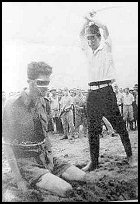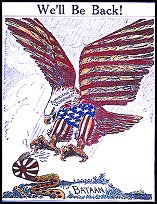
An American POW is executed |
Remembering the First Fight Against Fascism |

American propaganda poster "American Vengeance" remembers the defenders of Bataan. |

An American POW is executed |
Remembering the First Fight Against Fascism |

American propaganda poster "American Vengeance" remembers the defenders of Bataan. |
April
14, 1942 Thirty-five
hostages are killed in Paris for retaliation for underground attacks. Marshal
Petain, France’s greatest hero from World War I, destroys his reputation
by becoming the ceremonial head of the pro-Nazi Vichy government. Laval
remained as chief of the government’s administration and the real leader. The
French underground attacks a German command post in Arras. April
16, 1942 4000
Japanese land on Panay Island in the Philippines. The 7000 strong American-Filipino
force is ordered to the mountains to form guerrilla bands.
In a
daring and rare daylight raid, twelve RAF bombers hit the Augsburg diesel-engine
factory. The planes flew into Germany at 500’ and although 7 of the bombers
were shot down, the raid created such a sensation that the group leader,
John Nettleton was awarded the Victoria Cross. Nettleton would die a year
later in a raid over Turin. US
bombers launch the first airraid against the Japanese home islands (see
sidebar) US officials order a blackout of all coastal areas
on the eastern seaboard in an attempt to reduce the effectiveness of German
U-boats. The Germans scored a success against partisans
in the Dorogobuzh area. The great Russian partisan, Colonel Yefremov, severely
wounded in heavy fighting, took his own life rather than being captured
by the Germans.
Before pulling he pulled the trigger he extolled those around him to "kill
every one of the Fascists". Japanese
forces rout the 55th Chinese Division at Lashio in Burma. Resistance to the Japanese
on Cebu Island ends as the US-Filipino garrison surrenders.
An
assassination attempt is made against the leader of the French fascists,
Doriol. It fails.
Spain pledges
to send troops to support Germany’s war effort against Russia. Berlin
radio quoted Señor Suñer as saying that Spain hoped the Axis
powers would win the war because "a victory of the Allies would be tantamount
to a victory of bolshevism." The German
submarine U-459 sets sail. Unarmed, this floating gas station, known as
a ' Milch cow', heads toward American waters to fuel armed craft to extend
their patrol time. British
forces abandon the Yenangyaung oil fields in Burma. April
23, 1942
The
last of the Bataan Death March survivors arrive at Camp O’Donnell. Approximately
45,000 Filipino and 9,300 Americans survived the forced march. 8,000 Filipinos
and 650 Americans succumb to lack of food or water or the abuses of the
Japanese captors. April
25, 1942
General
Alexander decided that the defense of Burma was hopeless and ordered his
British and Indian forces back to India. April
27, 1942
For
the fourth consecutive night, RAF bombers returned to Rostov. After a “disappointing”
initial raid, the British succeed in destroying about 70% of the city and
badly damaging the Heinkel factory.
|
April
18, 1942 - Sixteen
Army B-25 bombers struck Tokyo, Yokohama, Kobe and Nagoya Japan today.
The attacks caused little physical damage to the Japanese home island,
but the attack cause severe consternation in the Japanese military high
command and other officials. It is felt that the blow was in large part
responsible for the Japanese reducing their plans for continued expansion
in the Pacific. Also, the Japanese diverted their limited resources to
the occupation of Chekiang province in China in order to prevent this type
of over flight mission from happening again. The
raid was a major moral booster in America. This was some of the first really
good news the country had received since the start of the war in December.
When the press realized that the Army had no airfields in range of the
B-25s to hit Japan, they asked Roosevelt where the planes came from. He
said, “Shangri-La”.
The Doolittle raid was one of the most bizarre if not daring stunts to be pulled in the war. James “Jimmy”. Doolittle took his flight of 16 B-25 Mitchell medium bombers and strapped them (literally) to the deck of the USS Hornet. The plan was to launch the bombers from the carrier, attack Japan and then make their way to friendly bases in China.
Battling
heavy seas and under the constant threat of discovery, the carrier and
its cargo of Army bombers snuck deep into enemy controlled waters. Just
10 hours from the scheduled launch, the task force was discovered by a
Japanese surface ship. Radio operators intercepted messages radioed from
the picket before the cruiser Nashville sunk the enemy. It was decided
that the attack would go forward immediately even though the range would
be to great to guarantee landing in friendly territory.
At
8:18 am, the first bomber lumbered down the deck of Hornet. Normally,
the B-25 needs 1200' for take-off, but Doolittle had only 435' of pitching
deck to work with. His plane barely reached takeoff speed when the heavily
loaded bomber disappeared under the lip of the deck, and just missed hitting
the water before recovering and lumbering toward Japan. The other 15 planes
followed suit during the next hour
Not
wasting fuel to form up, the planes headed for their targets independently.
Eight of the planes bombed their primary targets, while five hit secondaries.
Some of the planes hit Tokyo during a practice air raid and the locals
were extremely confused when real bombs started hitting the city.
Favorable tail winds allowed most of the planes to make it to China. One plane landed in Vladivostok where the plane and crew were interned (The USSR and Japan would remain at peace until August 1945). Two planes came down in Japanese occupied China. Of the 8 crew members who survived to be captured, three were executed, 4 of the other 5 survived imprisonment and were released at the end of the war. The remaining planes made forced landings in friendly territory. Doolittle's Raiders were instant heroes in the states, but returned to continue the fight against the enemy
1941 Archive:
1942 Archive:
Special Editions:
Editor's Corner Archive: The Past Through Tomorrow "It is quite frightening to realize just how similar our nation’s actions have been and appear to be heading when compared this way..." Afghanistan and Vietnam: When the “war against terrorism” began, many knowledgeable people warned that our operations in Afghanistan would turn into another Vietnam. Want to Win - Think Before You Lash Out - "If we are serious about taking the war to the enemy, it is time to look ..." The First Fight Against Fascism - We must remember the Spanish Civil War also. Arguing Victory - "... Each nation who fought against fascist tyranny in WWII brought with it part of whole needed to defeat that evil..." War, Glory, Honor and Remembrance - "War is a brutal and savage insult on human society..." The First
Casualty... in time of war, those in power are even more inclined
to hide the truth, since that truth is often manifest in the most gruesome
and terrible acts. Those wishing to contribute items. stories or comments should contact D.A. Friedrichs |